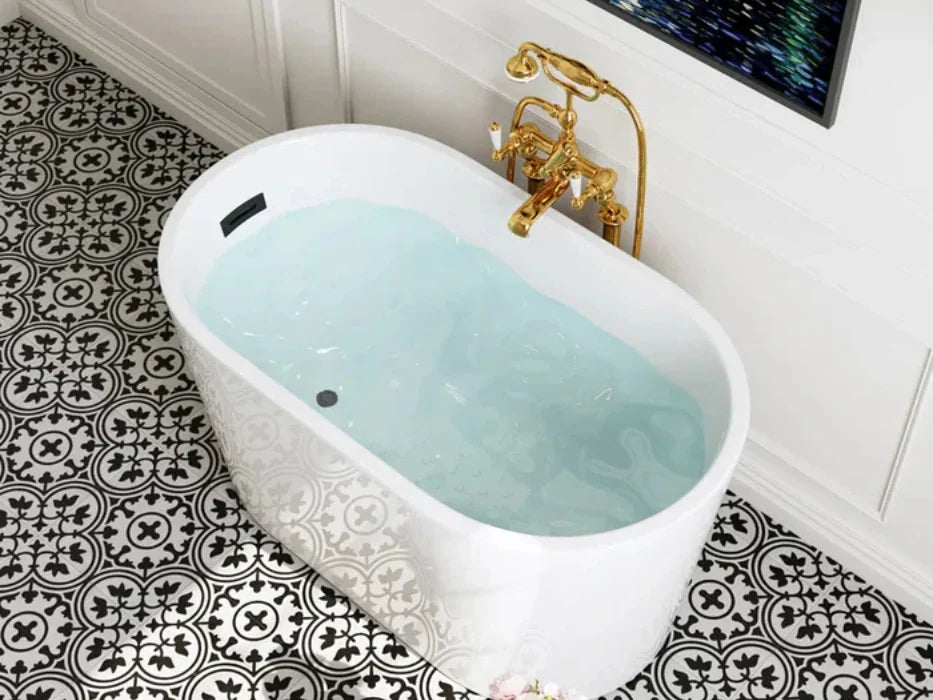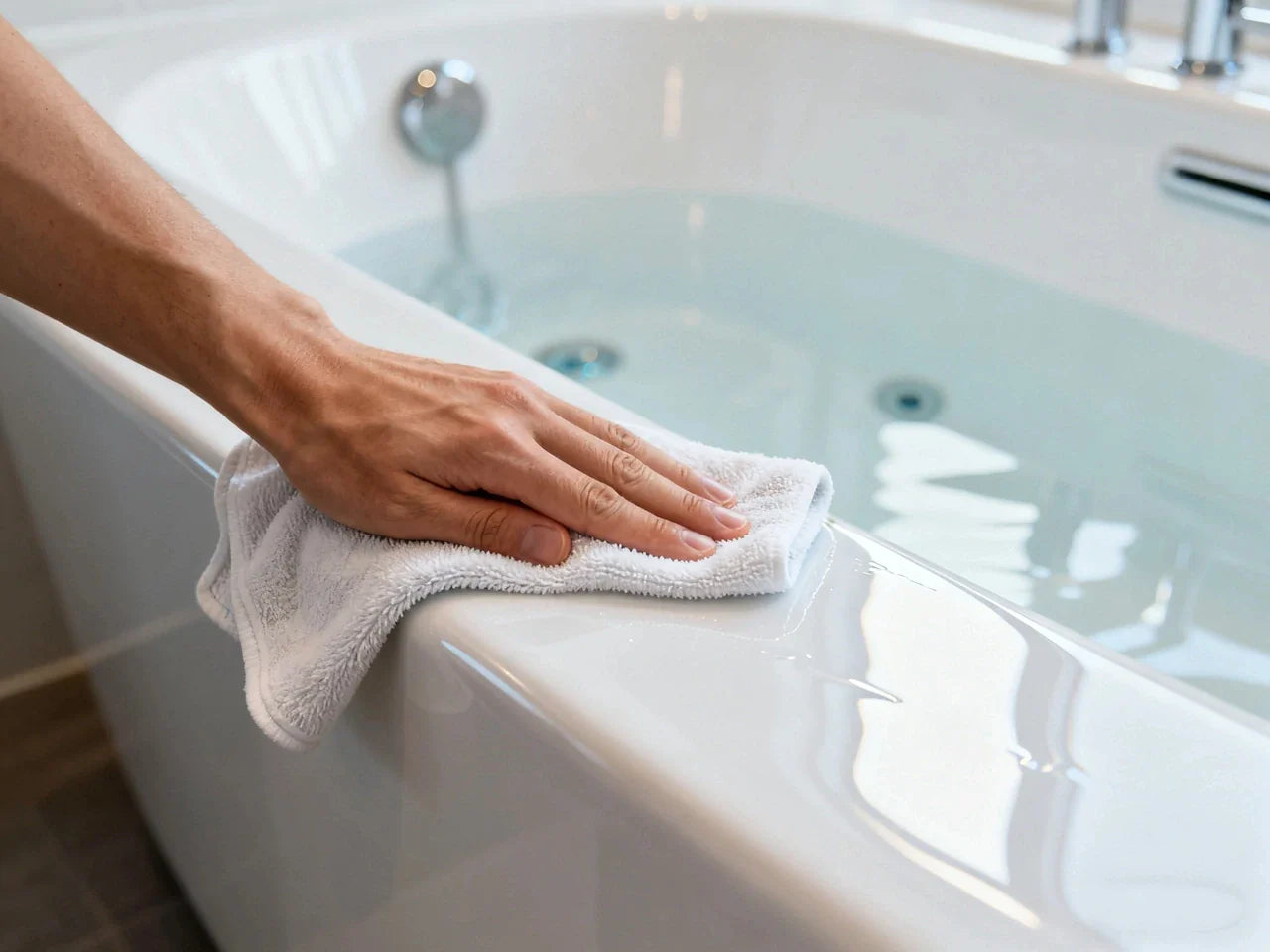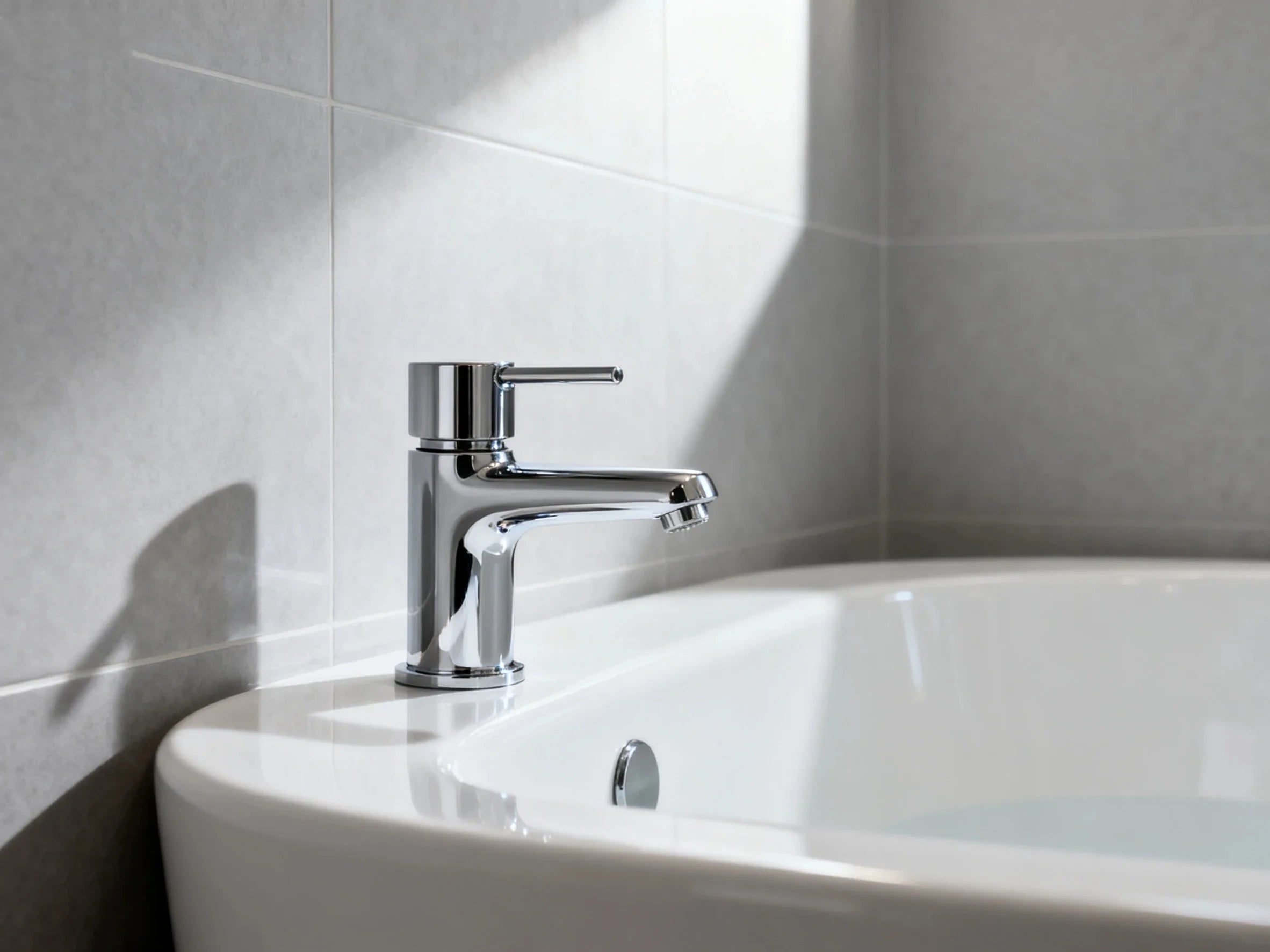Quick Start: Identify Your Stopper Type in 60 Seconds
Visual ID cues: lift-and-turn, push-pull, toe-touch, pop-up, trip-lever — what you see and how it behaves
- Lift-and-turn: A small knob on top that you twist to open and close. It often has a set screw under the cap or in the side of the post. It usually unscrews counterclockwise to remove.
- Push-pull: Push to close, pull to open. Looks like a round cap you can grasp with your fingers. Often threads onto a post; cap unscrews to reveal the shaft.
- Toe-touch: Flat, spring-loaded cap you press with your toe. Push once to close the drain, push again to open. Inside is a spring and o-ring; the cap and post unscrew for removal.
- Pop-up (stopper at the drain): Similar to toe-touch but may have a different internal mechanism; sometimes the cap free-spins unless you engage the hidden slot or hold the outer rim to catch threads.
- Trip-lever (lever-and-plunger): A lever on the overflow plate (the metal plate up on the wall of the tub). Moving the lever raises/lowers a plunger inside the overflow pipe that opens or closes the drain. The stopper you see at the drain may be a simple strainer or grate, with the real action inside the wall.
Fast decision tree (interactive quiz): answer 5 questions to pinpoint your stopper type
Do you see a lever on the overflow plate?
Yes → You have a trip-lever system.
No → Continue.
Do you push down on the stopper to close and push again to open?
Yes → Toe-touch or push-pull (toe-touch is flatter; push-pull cap usually pulls up with fingers).
No → Continue.
Do you twist a small knob to open/close?
Yes → Lift-and-turn.
No → Continue.
When you try to unscrew the cap, does it just spin without catching?
Yes → Likely pop-up (needs a trick to engage threads).
No → Continue.
Is the cap fixed and there’s only a metal grate at the drain while the lever is on the overflow?
Yes → Trip-lever with internal plunger.
Tool checklist by stopper type
- Lift-and-turn: Flathead screwdriver, small Allen wrench set, small plier or channel-lock (jaws wrapped with cloth), flashlight.
- Push-pull / Toe-touch: Flathead screwdriver, pliers (cloth-wrapped jaws), replacement o-ring if needed, faucet grease.
- Pop-up: Flathead for the slot, pliers to hold the rim, soft cloth, grease.
- Trip-lever: Phillips screwdriver for the overflow cover, needle-nose pliers, tape measure to note rod length, rags.

Visual aid: comparison table of common bathtub drain stoppers
| Stopper type | How it operates | Where it locks | Typical removal start | Common tools |
| Lift-and-turn | Twist knob to open/close | Set screw on post | Twist cap; check for hidden set screw | Flathead, Allen, pliers |
| Push-pull | Pull up to open, push down to close | Threads on post | Unscrew cap; lift out post | Flathead, pliers |
| Toe-touch | Tap with toe to toggle | Spring and post | Unscrew cap; inspect spring | Flathead, pliers |
| Pop-up | Press cap; may free-spin | Internal slot | Hold rim or use slot to engage | Flathead, pliers |
| Trip-lever | Lever on overflow moves plunger | Inside overflow pipe | Remove overflow plate; pull linkage | Phillips, needle-nose |
Step-by-Step: Change Tub Drain Stopper (All Types)
Lift-and-turn removal
- Put the stopper in the open position.
- Hold the handle/knob and try turning the cap counterclockwise. If it won’t move or just spins, continue.
- Look for a small set screw on the side of the post or under a top cap. Pry the cap gently with a flathead screwdriver if needed, taking care not to scratch the finish.
- Use the correct driver (flathead or Allen wrench) to loosen the set screw 1–2 turns.
- Twist the stopper counterclockwise to unthread it from the post. If the post remains, unthread the shaft by turning the post counterclockwise.
- Lift out the stopper and set aside any small screws in a cup.
- Most units unscrew counterclockwise once the set screw is free.
- If you must use pliers for extra grip, wrap the jaws with a cloth to protect finishes.

Push-pull and toe-touch removal
- Put the stopper in the open position.
- Grasp the stopper cap and twist counterclockwise to remove it. If it’s slippery, use a rubber jar gripper.
- Lift the cap off; then unthread the lower post/shaft counterclockwise from the drain fitting.
- Inspect the spring (toe-touch) and the o-ring for wear or cracks. Replace as needed.
- Clean threads and the strainer/crossbars in the drain.
Pop-up removal
- Put the stopper in the open position.
- Try to twist off the cap counterclockwise. If it spins without catching, place a flathead screwdriver in the internal slot (revealed when slightly lifted) to engage threads, or gently hold the outer rim with cloth-wrapped pliers while turning.
- Lift off the cap and unscrew any inner post.
- Clean and inspect the mechanism and o-ring.
Trip-lever (waste-and-overflow) removal
- Remove the two screws on the overflow plate with a Phillips screwdriver.
- Gently pull the lever assembly, rod, and plunger straight out of the overflow opening. Note the orientation and the rod length. A phone photo helps.
- If your drain has a separate grate or cover, remove it to clear hair and debris below.
- Clean the plunger and linkage. If the plunger is worn or swollen, consider replacing the assembly.
- Reinstall by sliding the plunger and rod back inside the overflow pipe, align the plate, and secure the screws.
- Many homeowners finish removal in minutes with the right tool.
- Pros often remove common styles in under five minutes; a large share of drainage issues are cleared by cleaning under the stopper.
Visual: Step sequence cards for each type
- Lift-and-turn: Open → Find set screw → Loosen → Twist off cap → Unthread post → Clean.
- Push-pull/Toe-touch: Open → Twist off cap → Unthread post → Inspect spring/o-ring → Clean.
- Pop-up: Open → Stabilize rim or use slot → Twist off cap → Clean.
- Trip-lever: Remove overflow plate → Pull linkage → Clean plunger → Reinstall.

Troubleshooting Stuck, Stripped, or Spinning Stoppers
Hidden set screws and caps: where to look, which drivers to try, how to break threadlock gently
Stuck threads: plier technique, penetrating oil, light heat caution, protect chrome with a rag
- Wrap the jaws with a cloth to prevent scratches.
- Apply steady, controlled torque, not jerky force.
- Add a drop of penetrating oil at the thread line and wait 10–15 minutes.
- As a last resort, brief, low heat from a hair dryer may soften gunk, but avoid heating plastic trims or caulk. Never use open flame near the tub.
Free-spinning cap/knob: engage the internal slot with a flathead or hold the outer rim with pliers to start threads
Why won’t my tub stopper unscrew?
- A concealed set screw is still tight.
- Mineral buildup or soap scum has glued the threads.
- Cross-threading from a previous install.
- Dried thread sealant or adhesive.
Clean, Inspect, and Prep the Drain for Reassembly
Clear hair and debris at crossbars: most clogs are cleared after accessing below the stopper
Lubrication and seals: apply faucet grease to threads and o-rings; inspect/replace gaskets; ensure smooth travel
Check drain flange condition: corrosion, stripped threads, or loose flange; when a drain key or new flange is needed
- Rounded or stripped threads where posts attach.
- A flange that spins in the tub without tightening.
- Leaks around the flange.
Do I need plumber’s putty or silicone for a tub drain?
Visual: quick maintenance checklist
- Remove hair and debris from crossbars.
- Clean threads and cap.
- Replace o-rings or springs as needed.
- Light coat of faucet grease on moving parts.
- Wipe the tub surface and polish the cap after installation.
Reinstall or Replace: Fit, Height, and Seal Done Right
Thread engagement and height adjustment: ensure full open/close travel; avoid cross-threading
Avoid over-tightening: hand-snug + minor turn; finish protection; when to use Teflon tape on threaded posts
Leak and function tests: fill/hold/drain timing; tweak height or spring tension; final polish
- Fill the tub a few inches and watch for drips under the tub if accessible.
- Time the seal: water should hold. If it seeps, adjust cap height or replace the o-ring.
- Test the drainage in open mode. If it’s slow, recheck for debris at the crossbars.
How tight should a tub drain stopper be?

Choosing a Replacement Stopper: Compatibility, Cost, Eco Options
Measure and match: 1-1/2 in standard drains; brand-specific vs universal; finish matching
- The drain opening and thread standard.
- Post/thread compatibility for your stopper assembly.
- Finish match: chrome, brushed nickel, matte black, etc.
- Some stoppers are brand-specific; others are universal kits.
Cost-effectiveness: replace wear parts vs full kit; longevity, warranty, parts availability
- O-ring/spring kits: low cost.
- Replacement stopper only: modest cost.
- Full waste-and-overflow kit: higher, but includes trim and gaskets.
Eco-friendly picks: repairable designs, durable materials, reduce single-use plastics and premature replacements
Which bathtub stopper is best?
- Easiest to use: push-pull or toe-touch.
- Simple, repairable: lift-and-turn with accessible set screw.
- Hidden control: trip-lever (good for deep tubs and clean look). Choose the style you prefer to operate and maintain, and ensure parts are available.
Tools, Safety, and Time: What You’ll Really Need
Core toolkit and substitutions
- Screwdrivers: flathead and Phillips
- Small Allen wrench set
- Channel-lock pliers or small adjustable pliers (wrap jaws)
- Drain key (only if changing the drain flange)
- Penetrating oil
- Faucet grease
- Flashlight and rubber jar gripper
- Rags, small brush, needle-nose pliers
Safety and surface protection
- Wear gloves and eye protection if pulling hair clogs.
- Use painter’s tape around shiny trim if you’ll use tools near it.
- Place a rag under plier jaws to avoid scratches.
- Never mix drain chemicals; if you used a chemical cleaner, flush well and wait before working.
Time estimates (by type and condition)
| Task | Typical time |
| Lift-and-turn / Pop-up removal and clean | 5–10 minutes |
| Push-pull / Toe-touch removal and clean | 5–10 minutes |
| Trip-lever remove, clean plunger, reinstall | 15–30 minutes |
| Add for older/corroded hardware | +10–20 minutes |
Pro Tips, Data, and Real-World Cases
Gentle force over brute force
Common mistakes to avoid
- Over-tightening caps and posts
- Scratching visible chrome by using bare plier jaws
- Losing tiny set screws (work over a towel)
- Misidentifying a trip lever and tugging at the wrong part
- Cross-threading during installation
When to call a pro
- Seized or spinning drain flange
- Damaged crossbars or cracked overflow pipe
- Persistent leak behind the overflow plate
- Stripped threads where the stopper post attaches
Mini case studies
- Older lift-and-turn with hidden set screw: The cap wouldn’t budge. A quick lift of the top revealed a tiny side set screw. A small Allen loosened it, and the cap spun off by hand.
- Free-spinning pop-up: The user twisted and nothing happened. Holding the cap’s rim with a cloth and engaging the center slot with a flathead caught the threads; removal took under a minute.
- Corroded toe-touch: The post was stuck. A drop of penetrating oil and cloth-wrapped pliers with slow, steady torque broke the bond without marring the finish.

Summary
10-step actionable checklist to change tub drain stopper
- Identify your stopper type.
- Gather tools required for that type.
- Protect finishes with tape or cloth.
- Access the cap or knob.
- Locate and release any set screw.
- Turn counterclockwise to remove; take out the drain plug bathtub safely.
- Clear debris and hair; clean and grease threads.
- Reinstall or insert the new stopper; adjust height and mechanism travel.
- Test seal and drainage; tweak as needed.
- Schedule a quick clean every few months to prevent clogs.
Visual/interactive wrap-up
| Type | Primary tools | Typical removal note |
| Lift-and-turn | Flathead, Allen, pliers | Find and loosen set screw |
| Push-pull | Flathead, pliers | Cap unthreads; check o-ring |
| Toe-touch | Flathead, pliers | Cap/post unthread; inspect spring |
| Pop-up | Flathead, pliers | Hold rim or use slot to engage threads |
| Trip-lever | Phillips, needle-nose | Remove overflow plate; pull linkage |
| Symptom | Fix | Tool |
| Cap free-spins | Hold rim or use internal slot | Pliers + flathead |
| Won’t unscrew | Loosen hidden set screw; add oil | Allen/flathead + oil |
| Poor seal | Replace o-ring; adjust height | O-ring + fingers |
| Slow draining | Clear hair at crossbars | Needle-nose + brush |
| Post wobbles | Add Teflon tape or replace post | Teflon tape |









Leave a comment
This site is protected by hCaptcha and the hCaptcha Privacy Policy and Terms of Service apply.